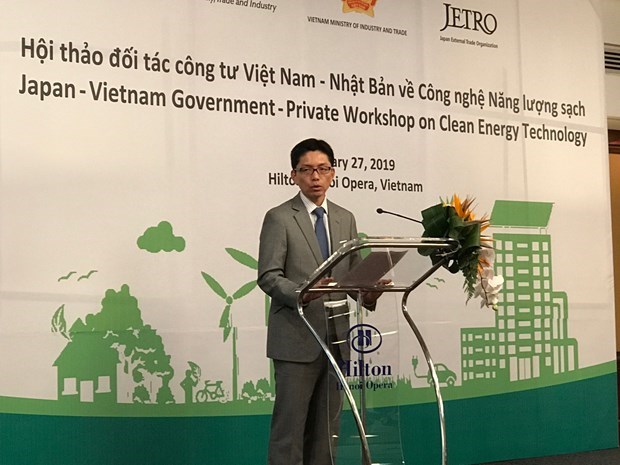Ministry: Vietnam's electricity system ranks second in Southeast Asia
 Deputy Minister of Industry and Trade Hoang Quoc Vuong addresses Japan-Vietnam Public-Private Partnership Workshop on Clean Energy Technology the workshop. (Photo: VietnamPlus)
Deputy Minister of Industry and Trade Hoang Quoc Vuong addresses Japan-Vietnam Public-Private Partnership Workshop on Clean Energy Technology the workshop. (Photo: VietnamPlus)
According to a survey of the Vietnam Electricity Corporation (EVN), at the end of 2018, Vietnam's electricity system ranked second among 10 Southeast Asian countries and 23rd in the world in terms of capacity, which reaches nearly 50,000 MW at present.
The information was released by Deputy Minister of Industry and Trade Hoang Quoc Vuong at the "Japan-Vietnam Public-Private Partnership Workshop on Clean Energy Technology," recently held in Hanoi by the Ministry of Industry and Trade (MoIT) in collaboration with the Ministry of Economy, Trade and Industry of Japan.
Pressure on energy consumption on the environment
According to Deputy Minister Vuong, Vietnam's electricity system has reached nearly 50,000 MW and the capacity has basically met the country’s electricity demand with an annual growth rate of over 10 percent.
However, Vuong said that the increasing demand for energy and electricity consumption in years has caused adverse impact on national sustainable development such as environment pollution and exhausted natural resources.
Aya Yoshida, head of the Asia Pacific Division and Partnership, Global Energy Relations Division at IEA, provided more information on the unsustainability in energy use in many countries around the world.
For example, the amount of CO2 emissions related to global energy has increased for two consecutive years from 2017-2018 after standing still in 2016.
According to Yoshida, more importantly, Southeast Asia is about to become a net importer of oil, gas and coal, that will increase vulnerability to price volatility and raise concern on energy security.
"Despite the development of the clean technology, particularly renewable energy sources to replace traditional energy, the amount of CO2 emissions has increased," said Aya Yoshida.
Meanwhile, the accumulated electricity industry investment in Southeast Asia by 2040 is expected to be huge at 1.25 trillion USD, equivalent to an average of about 50 billion USD per year (double the current level), in which the transmission and distribution account for 54 percent and power generation accounts for 46 percent.
 A Japanese representative at the workshop (Photo: VietnamPlus)
A Japanese representative at the workshop (Photo: VietnamPlus)
More incentives for renewable energy
According to the Ministry of Industry and Trade, at the end of 2018, the total capacity of hydropower plants in the system hit over 22,000 MW, of which the capacity of small hydroelectric plants under 30 MW was about 4,000 MW.
In addition, the capacity of wind and solar power plants that will be put into operation by the end of 2019 is expected to stand at 1,000 MW.
"This figure exceeds the plan set in the seven-adjustment electricity plan, which says that by 2020, solar power will be 850 MW and wind power will be 800 MW," said the representative of the Ministry of Industry and Trade.
Pham Huong Giang, deputy head of the Renewable Energy Division at the Ministry of Industry and Trade, said only 11 out of 63 provinces and cities across the country have potential for the development of wind power, mainly central coastal localities.
Moreover, many investors said that the mechanism to attract wind power investment has not been attractive, so state agencies need to further invest and support.
“According to experts’ assessment, Vietnam's renewable energy is at an early stage and to attract investors, along with the FIT pricing mechanism, the Ministry of Industry and Trade is building a mechanism on renewable energy, bidding and auction to attract stronger to this field,” said Giang.
Regarding current regulations, Deputy Minister Vuong said that the Government has devised and promulgated a law on economical and efficient use of energy, while making public general development plans for the electricity industry for each 10-year period, with taking into account the next 10 years.
Accordingly, the plans are reviewed and adjusted every five years to ensure that the electricity system is properly developed and in line with the development requirements of the economy as well as the trend of the world. Besides, many mechanisms are issued to encourage the development of clean and renewable energy such as hydroelectricity, wind power, solar power, biomass, and electricity from waste.
With an attractive price mechanism, many investors have registered to invest in wind and solar projects in Vietnam, whose number is likely to surpass the growth target of 20 percent as set by the Government, he said.
“With the Government's attractive incentives along with the development of solar and wind power technology, the goal of achieving 20 percent of renewable energy system capacity (excluding hydro power) will be achievable,” the Deputy Minister added.
According to Yoshida, Vietnam is at an early stage, so the Government needs to develop an appropriate mechanism, which helps reduce risks for investors in developing renewable energy projects.
She suggested ASEAN countries study to integrate the electricity system in the region, because this can be an effective solution to enhance electricity security and promote economic growth and accelerate the deployment of renewable energy.
“Investment in energy is an important issue in Southeast Asia. Renewable energy and energy saving can help reduce air pollution, the amount of CO2 emissions and energy imports, but it is necessary to have best practice policies to cut costs and accelerate implementation,” said Yoshida./.













